Study on Queue Length in the Whole Process of a Traffic Accident in an Extra-Long Tunnel
Abstract
:1. Introduction
- (1)
- A video system was placed inside the lengthy tunnel; the information gathered from it is clear and trustworthy, and it is continuously arranged at a specific distance. As a result, the side-mounted video data were selected as the data source for the model analysis in this paper, which could provide data support for estimating queue length in real time.
- (2)
- Based on real-time data input, this paper analyzed the influence of forward and backward shock waves on vehicle queue length and revealed the process mechanism of the formation, spread, and dissipation of vehicle queue in the overall process of traffic accidents. There are relatively few studies that account for the evolution characteristics of vehicle queue length in the whole process of accidents.
- (3)
- According to [27,28,29,30,31], the length of the vehicle line in a particular section was calculated by estimating the difference between the number of vehicles entering and exiting the area through a given amount of time. To calculate the length of vehicles queuing in space, the vertical queue length was split by the density of vehicles. Since it is challenging to collect continuous traffic variables in a real-world traffic setting, the detector cleverly collects discrete values of traffic flow variables. In order to increase the precision of vehicle queuing estimation, the technique suggested in this paper was used to thoroughly investigate the congestion characteristics of traffic flow after accidents in tunnels.
2. Materials and Methods
2.1. Characteristics of Traffic Flow Parameters in the Entire Process of Traffic Accidents
2.2. Analysis of the Evolutionary Process of Traffic-Accident Vehicle Queue Length
2.2.1. Queue Generation
2.2.2. Queue Spread
2.2.3. Queuing Dissipation
- (1)
- The traffic-flow running state when the traffic flow after control meets the queuing traffic flow.
- (2)
- Traffic flow running state after accident clearance
- (3)
- The running state of traffic flow when the traffic flow after control meets the saturated traffic flow.
2.3. Maximum Queue-Length Estimation Model
2.4. Real-Time Estimation Model of Vehicle Queue Length in the Whole Process
2.4.1. Implementation Process of Estimating Vehicle Queue Length in Real Time
2.4.2. Real-Time Estimation Model of Vehicle Queue Length
2.4.3. Determination of Residual Capacity of the Accident Section
3. Results and Discussion
3.1. Data Preparation
3.2. Maximum Queue-Length Estimation Model Verification
3.3. Real-Time Estimation Model in the Whole-Process Queue-Length Verification
3.4. Model Accuracy Analysis
3.4.1. Time Interval Analysis
3.4.2. Data Sliding Smoothing Analysis
3.5. Compared with the Input and Output Model
4. Conclusions
- (1)
- Using the monitoring video data in the long tunnel, the maximum queue-length estimation model based on the traffic-flow shock-wave theory and the whole-process queue-length estimation model based on real-time data input were constructed based on an analysis of the evolution law of the queue length during the entire process of traffic accidents in the tunnel. The effect of data acquisition interval and data smoothing on the model’s precision was investigated. The relevant parameters in the model are defined in Appendix A.
- (2)
- According to the results, the model’s accuracy is greatest when the traffic flow data with an acquisition time interval T of 30 s are not smoothed; the accuracy for the maximum queue length and the total process queue length are 92.22% and 84.34%, respectively. The data smoothing procedure does not improve the model’s highest accuracy, but it has a significant effect when the time interval is between 5 and 15 s. There is no significant effect of sliding window length on the results.
- (3)
- Example verification demonstrates that the accuracy of the maximum queue-length estimation model based on shock-wave theory is 92.34%, and that the accuracy of the whole-process queue-length real-time estimation model based on shock-wave theory is 83.05%, reflecting the change rule of vehicle queue length under various control measures in real time. The accuracy of the whole-process queue-length estimation model presented in this paper is 83.05%, whereas the accuracy of the input–output model is 73.85%. The accuracy of the maximum queue-length estimation model based on shock-wave theory is 93.62%, while the accuracy of the input and output model is 87.24%; therefore, the model presented in this paper is more applicable.
Author Contributions
Funding
Data Availability Statement
Conflicts of Interest
Appendix A
| Parameter Symbolic | Implication |
|---|---|
| Normal traffic capacity in tunnel | |
| Optimal density of maximum capacity of accident section in tunnel | |
| Congestion density of accident section | |
| Traffic flow in the state | |
| Density in the state | |
| Shock wave generated between traffic flow running state and state | |
| Wave velocity of shock wave | |
| Time of accident | |
| Flow control start time | |
| Maximum queue-length time | |
| End time of accident | |
| Time when shock wave meets shock wave | |
| Time of the maximum queue-length tail vehicle passes through the accident section | |
| Maximum queue length | |
| Distance between the accident location and tunnel entrance | |
| Vehicle speed after control | |
| Upstream traffic volume in the tunnel | |
| Upstream velocity in the tunnel | |
| Upstream traffic density in the tunnel | |
| Residual capacity of the accident section | |
| Blocking density | |
| Control start time | |
| Duration of accident impact | |
| Number of queuing vehicles at the time interval in the congestion area | |
| Queue density at the time interval in the congested area | |
| Position numbering detector flow at time interval | |
| Density of the position number detector in the time interval | |
| ) | Detector number |
| ) | time interval |
| Detector number for the queue tail position in congestion area | |
| Detector number for the queue tail position in time interval congestion area | |
| Traffic flow of non-congested zone state in time interval | |
| Density of non-congested zone state in time interval | |
| + 2 | Detector number near the upstream from the queue tail position at the time interval |
| Velocity of shock wave in time interval | |
| Variation in queue length in the time interval T | |
| Real-time queue length | |
| Number of time intervals | |
| Difference in the number of vehicles arriving and leaving at time | |
| Number of vehicles arriving upstream from the congested area | |
| Number of vehicles leaving the congested area | |
| Queue traffic density in congested area | |
| Vehicle queue length at time |
References
- Wang, S.; Huang, W.; Lo Hong, K. Combining Shockwave Analysis and Bayesian Network for Traffic Parameter Estimation at Signalized Intersections Considering Queue Spillback. Transp. Res. Res. Res. Part C Emerg. Technol. 2020, 120, 102807. [Google Scholar] [CrossRef]
- Huang, W.; Hu, Y. A modified cell transmission model considering queuing characteristics for channelized zone at signalized intersections. Phys. A Stat. Mech. Its Appl. 2022, 605, 127977. [Google Scholar] [CrossRef]
- Wang, D.B.; Yang, G.C.; Tian, Z.; Wei, D. Traffic Queue Length Estimation at Permissive Left-Turn Signalized Intersections with Probabilistic Priority. J. Transp. Eng. Part A Syst. 2022, 148, 04022107. [Google Scholar] [CrossRef]
- Biswas, P.K.; Khan, S.M.; Piratla, K.; Chowdhury, M. Development and Evaluation of Statistical and Machine-Learning Models for Queue-Length Estimation for Lane Closures in Freeway Work Zones. J. Constr. Eng. Manag. 2023, 149, 04023023. [Google Scholar] [CrossRef]
- Li, J.; Wang, P.; Li, B.L.; Wei, X.Z. Method for Estimation of Vehicle Queues Length Based on Probability Theory. J. Jiangsu Univ. Nat. Sci. Ed. 2020, 41, 557–561. [Google Scholar]
- Latifi, H.; Goodarzi, M.J.; Amini, N.; Gilandeh, M.M.; Ali, S.S. Modelling of Queue Length in Freeway Work Zones–Case Study Karaj-Tehran Freeway. Promet-Traffic Transp. 2021, 33, 49–59. [Google Scholar]
- Pan, Y.; Luo, J.; Chen, J.Z.; Zhang, Q. Study on Decision Technology of Traffic Congestion and Evacuation in a Highway Tunnel. Chin. J. Undergr. Space Eng. 2019, 114, 303–309. [Google Scholar]
- Huang, Y.L. Research on Traffic Accident Impact and Evacuation Strategy of Expressway Tunnel. Master’s Thesis, Chang’an University, Xi’an, China, 2018. [Google Scholar]
- Yang, G.C.; Tian, Z.; Wang, D.B.; Xu, H. Queue Length Estimation for a Metered On-ramp Using Mesoscopic Simulation. Transp. Lett. 2018, 11, 570–579. [Google Scholar] [CrossRef]
- Amini, Z.; Pedarsani, R.; Skabardonis, A.; Varaiya, P. Queue-length Estimation Using Real-time Traffic data. In Proceedings of the 2016 IEEE 19th International Conference on Intelligent Transportation Systems, Rio de Janeiro, Brazil, 1–4 November 2016. [Google Scholar]
- Wang, Y.; Zhang, D.B.; Zhang, Y. GPS Data Mining at Signalized Intersections for Congestion Charging. Comput. Econ. 2022, 59, 1713–1734. [Google Scholar]
- Liu, D.B.; An, C.C.; Yasir, M.; Lu, J.; Xia, J.X. A Machine Learning Based Method for Real-Time Queue Length Estimation Using License Plate Recognition and GPS Trajectory Data. KSCE J. Civ. Eng. 2022, 26, 2408–2419. [Google Scholar] [CrossRef]
- Li, A.J.; Tang, K.S.; Dong, K.R. Estimation of Queuing Length at Signalized Intersections using Low-frequency Point Detector. J. Transp. Inf. Saf. 2018, 36, 57–64, 95. [Google Scholar]
- Chen, Q.; Li, M.; Wang, C.C. Cycle-Based Estimation on Lane-Level Queue Length at Isolated Signalized Intersection Using License Plate Recognition Data. J. Transp. Eng. Part A Syst. 2023, 149, 04022123. [Google Scholar] [CrossRef]
- Tan, C.F.; Wu, H.; Tang, K.; Tan, C.P. An Extendable Gaussian Mixture Model for Lane-Based Queue Length Estimation Based on License Plate Recognition Data. J. Adv. Transp. 2022, 2022, 1–14. [Google Scholar] [CrossRef]
- Tang, K.S.; Wu, H.; Yao, J.R.; Tan, C.P.; Ji, Y.B.B. Lane-based queue length estimation at signalized intersections using single-section license plate recognition data. Transp. B Transp. Dyn. 2022, 10, 293–311. [Google Scholar] [CrossRef]
- Sheng, Z.; Xue, S.; Xu, Y.; Li, D. Real-Time Queue Length Estimation with Trajectory Reconstruction Using Surveillance Data. In Proceedings of the 16th International Conference on Control, Automation, Robotics and Vision, Shenzhen, China, 1 June 2020. [Google Scholar]
- Aljamal, M.A.; Abdelghaffar, H.M.; Rakha, H.A. Real-Time Estimation of Vehicle Counts on Signalized Intersection Approaches Using Probe Vehicle Data. Inst. Electr. Electron. Eng. 2021, 22, 2719–2729. [Google Scholar] [CrossRef] [Green Version]
- Umair, M.; Farooq, M.U.; Raza, R.H.; Chen, Q.; Abdulhai, B. Efficient Video-based Vehicle Queue Length Estimation using Computer Vision and Deep Learning for an Urban Traffic Scenario. Processes 2021, 9, 1786. [Google Scholar] [CrossRef]
- Wei, L.; Li, J.H.; Xu, L.W.; Gao, L.; Yang, J. Queue Length Estimation for Signalized Intersections under Partially Connected Vehicle Environment. J. Adv. Transp. 2022, 2022, 1–11. [Google Scholar] [CrossRef]
- Comert, G.; Begashaw, N. Cycle-to-cycle queue length estimation from connected vehicles with filtering on primary parameters. Int. J. Transp. Sci. Technol. 2022, 11, 283–297. [Google Scholar] [CrossRef]
- Liu, H.; Liang, W.; Rai, L.; Teng, K.; Wang, S.L. A Real-Time Queue Length Estimation Method Based on Probe Vehicles in CV Environment. IEEE Access. 2019, 7, 20825–20839. [Google Scholar] [CrossRef]
- Tan, C.P.; Yao, J.R.; Tang, K.S. Queue Length Distribution Estimation at Signalized Intersections Based on Sampled Vehicle Trajectory Data. China J. Highw. Transp. 2021, 34, 14. [Google Scholar]
- Zhang, W.B.; Ye, J.Y.; Bai, Z.S.; Li, X.Y. Queue Length Estimation and Accuracy Assessment Method for Intersections Based on Trajectory Data. China J. Highw. Transp. 2022, 35, 10. [Google Scholar]
- Gao, K.; Han, F.; Dong, P.; Xiong, N.X.; Du, R.H. Connected Vehicle as a Mobile Sensor for Real Time Queue Length at Signalized Intersections. Sensors 2019, 19, 2059. [Google Scholar] [CrossRef] [PubMed] [Green Version]
- Jing, Q.; Li, K. Estimating Queue Length under Connected Vehicle Technology: Using Probe Vehicle, Loop Detector, Fused Data. Transp. Res. Rec. 2018, 2366, 35–39. [Google Scholar]
- Sharma, A.; Bullock, D.M.; Bonneson, J.A. Input-output and Hybrid Techniques for Real-time Prediction of Delay and Maximum Queue Length at Signalized Intersections. Transp. Res. Rec. J. Transp. Res. Board 2007, 2035, 69–80. [Google Scholar] [CrossRef] [Green Version]
- Yi, P.; Tian, Z.Z.; Zhao, Q. Consistency of Input-output Model and Shock Wave Analysis in Queuing and Delay Estimations. J. Transp. Syst. Eng. Inf. Technol. 2008, 8, 146–152. [Google Scholar]
- Wang, Y.J.; Xu, J.M.; Li, W.Y. Estimation Model of Maximum Queue Length for Traffic Congestion at Urban Intersections. West. China Commun. Sci. Technol. 2009, 2, 84–90. [Google Scholar]
- Liu, H.X.; Wu, X.K.; Ma, W.T.; Hu, H. Real-time Queue Length Estimation for Congested Signalized Intersections. Transp. Res. Part C Emerg. Technol. 2009, 17, 412–427. [Google Scholar] [CrossRef]
- Carlson, R.C.; Papamichail, I.; Papageorgiou, M.; Messmer, A. Optimal Mainstream Traffic Flow Control of Large-scale Motorway Networks. Transp. Res. Part C Emerg. Technol. 2010, 18, 193–212. [Google Scholar] [CrossRef]
- National Research Council (U.S.). Highway Capacity Manual; Transportation Research Board: Washington, DC, USA, 2010.

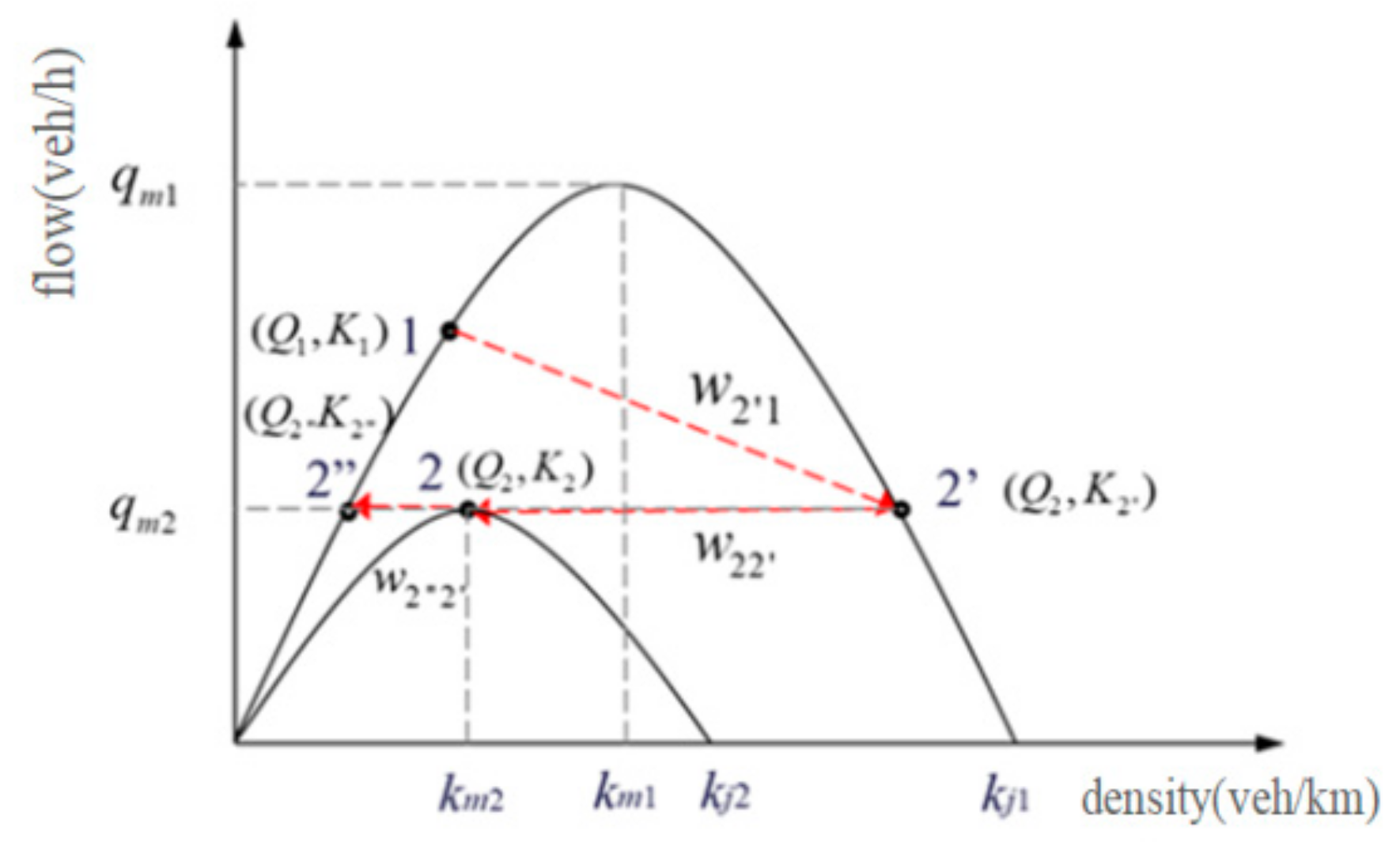

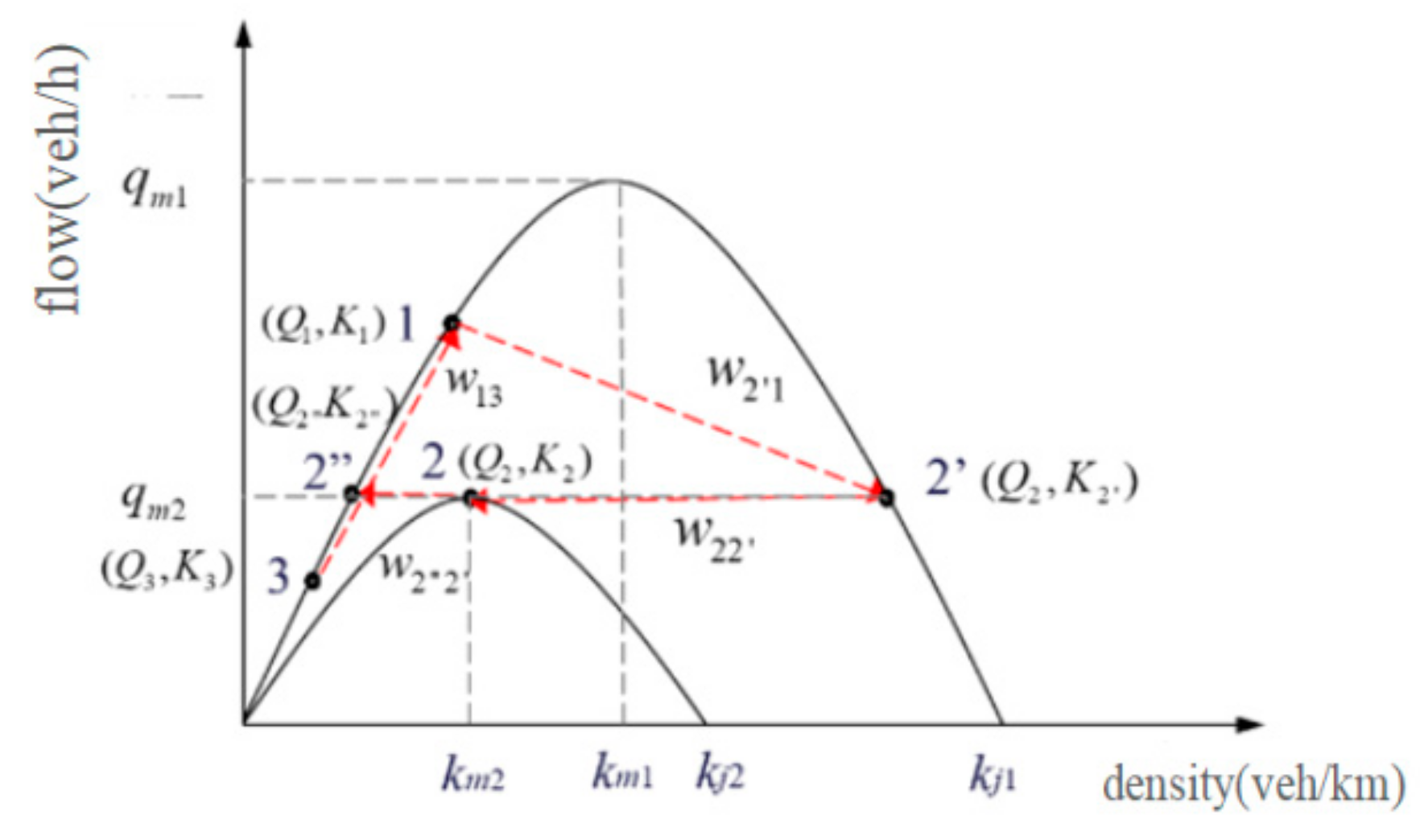

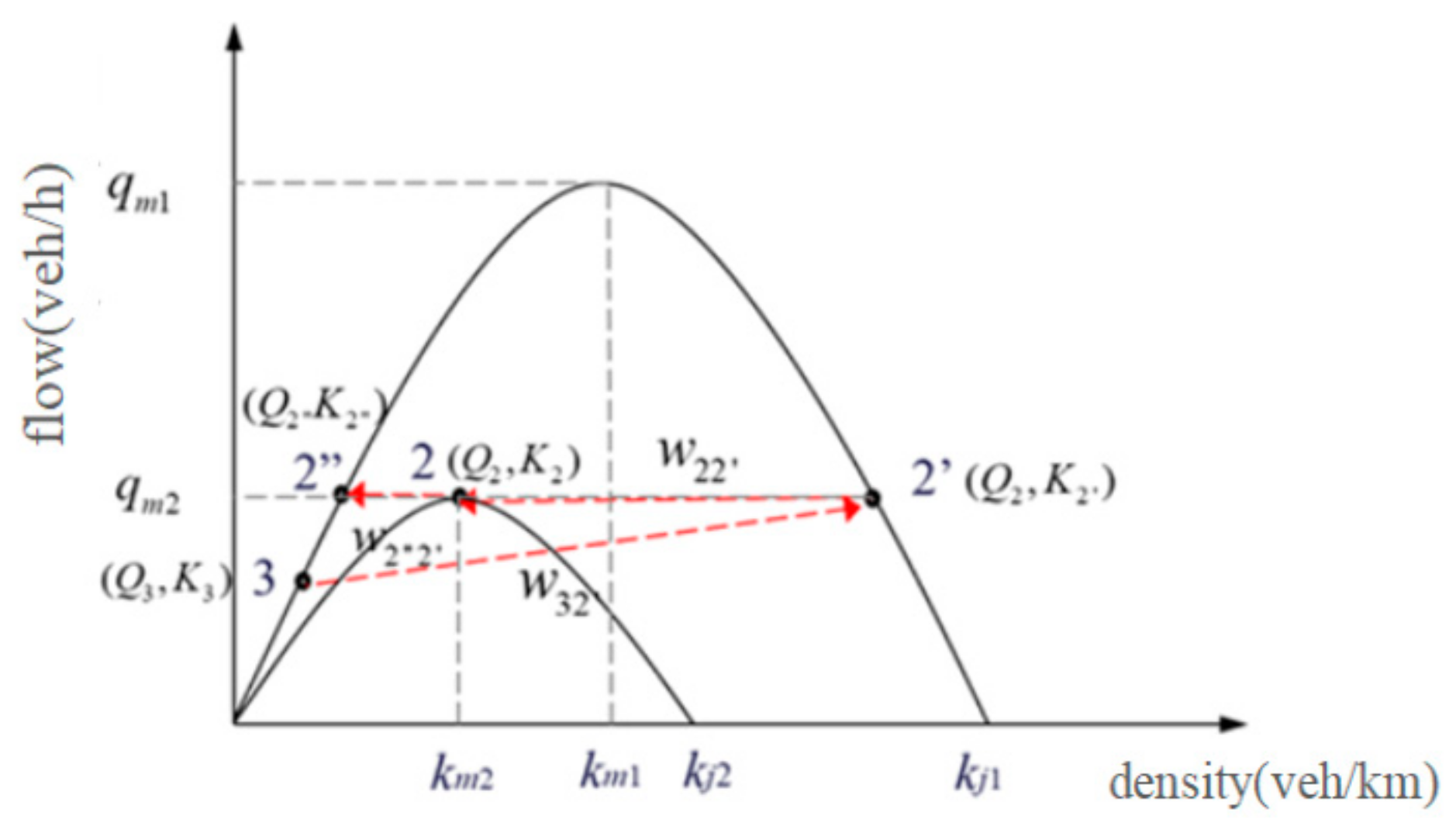

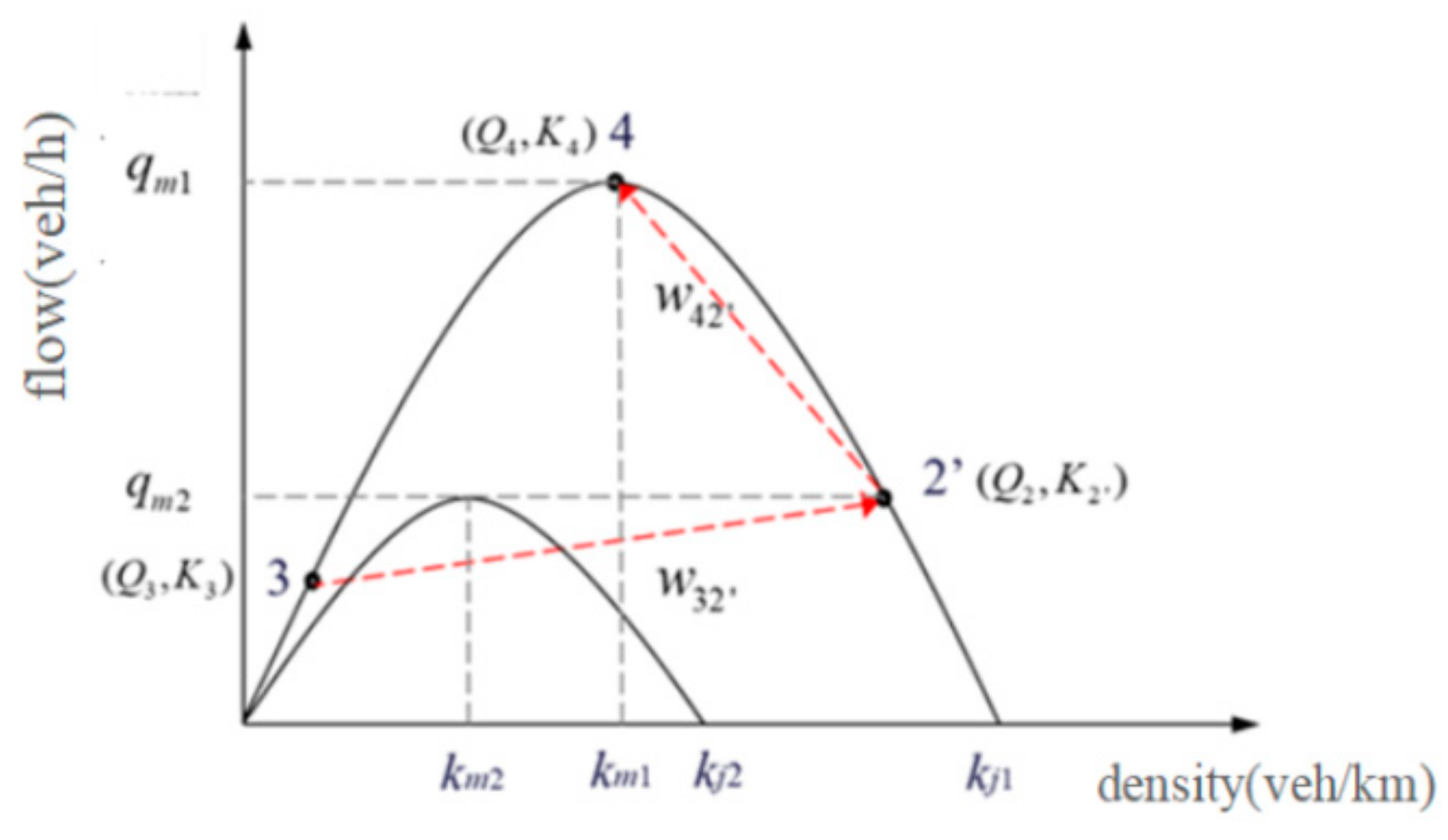

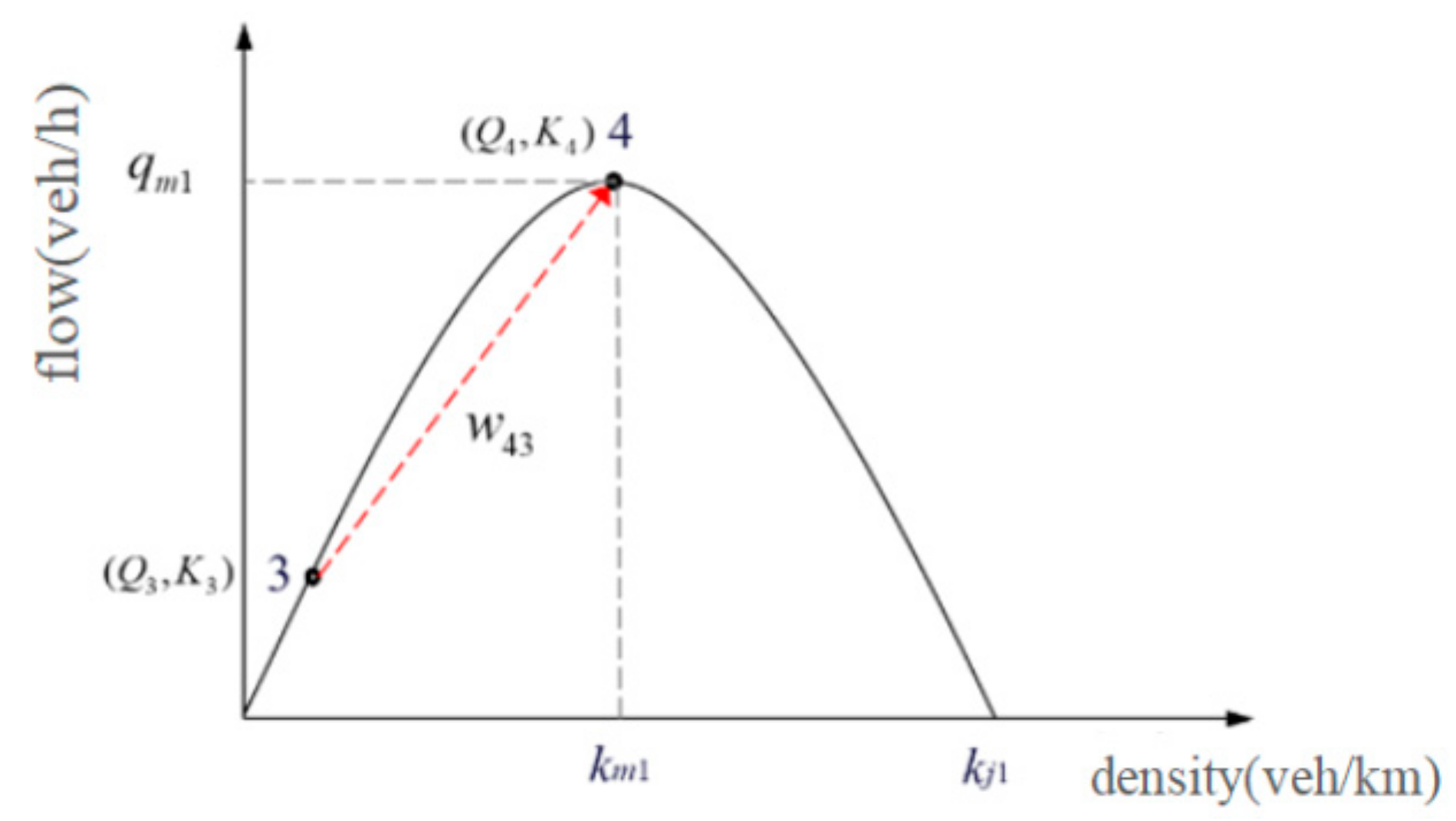

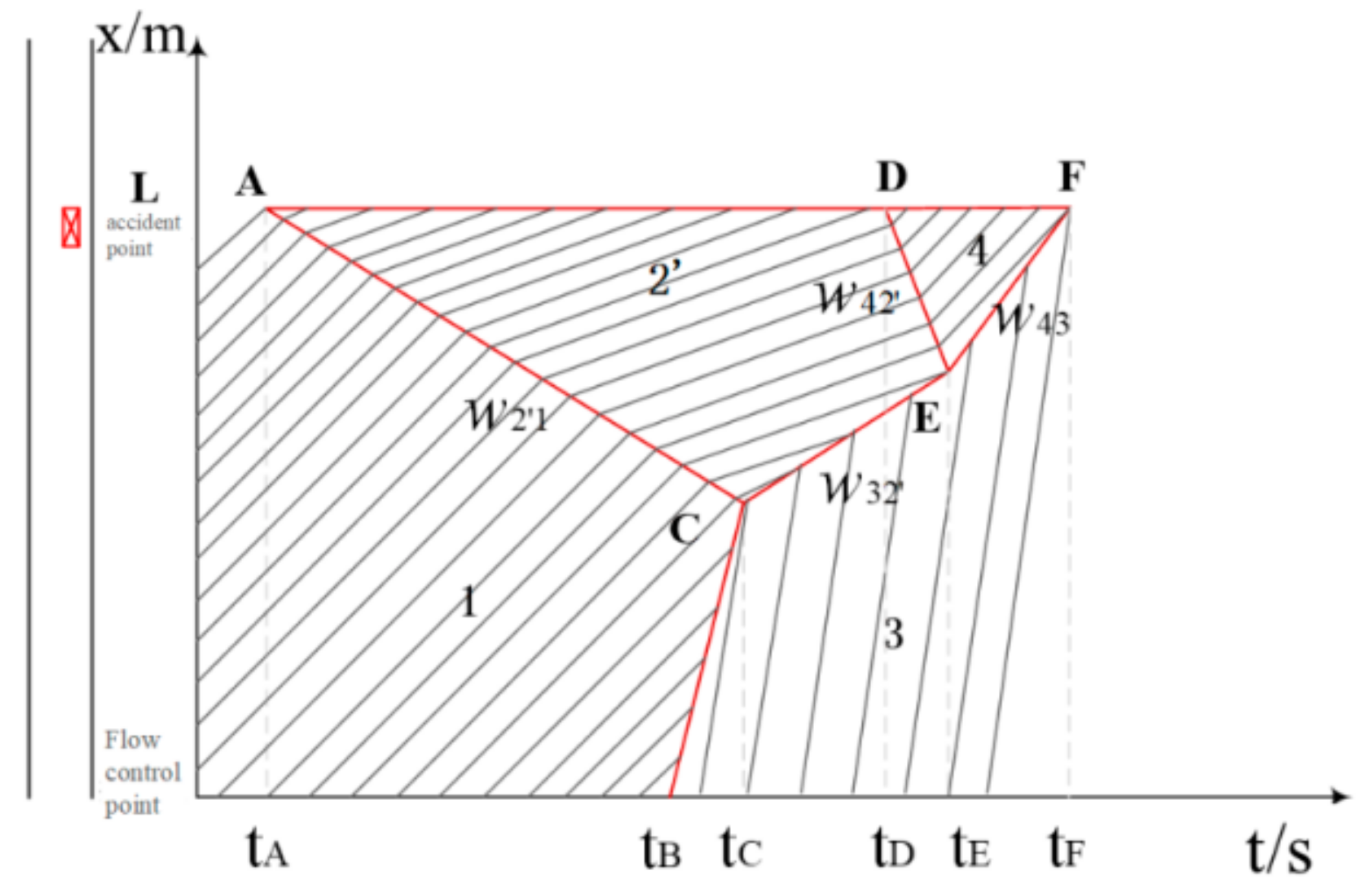


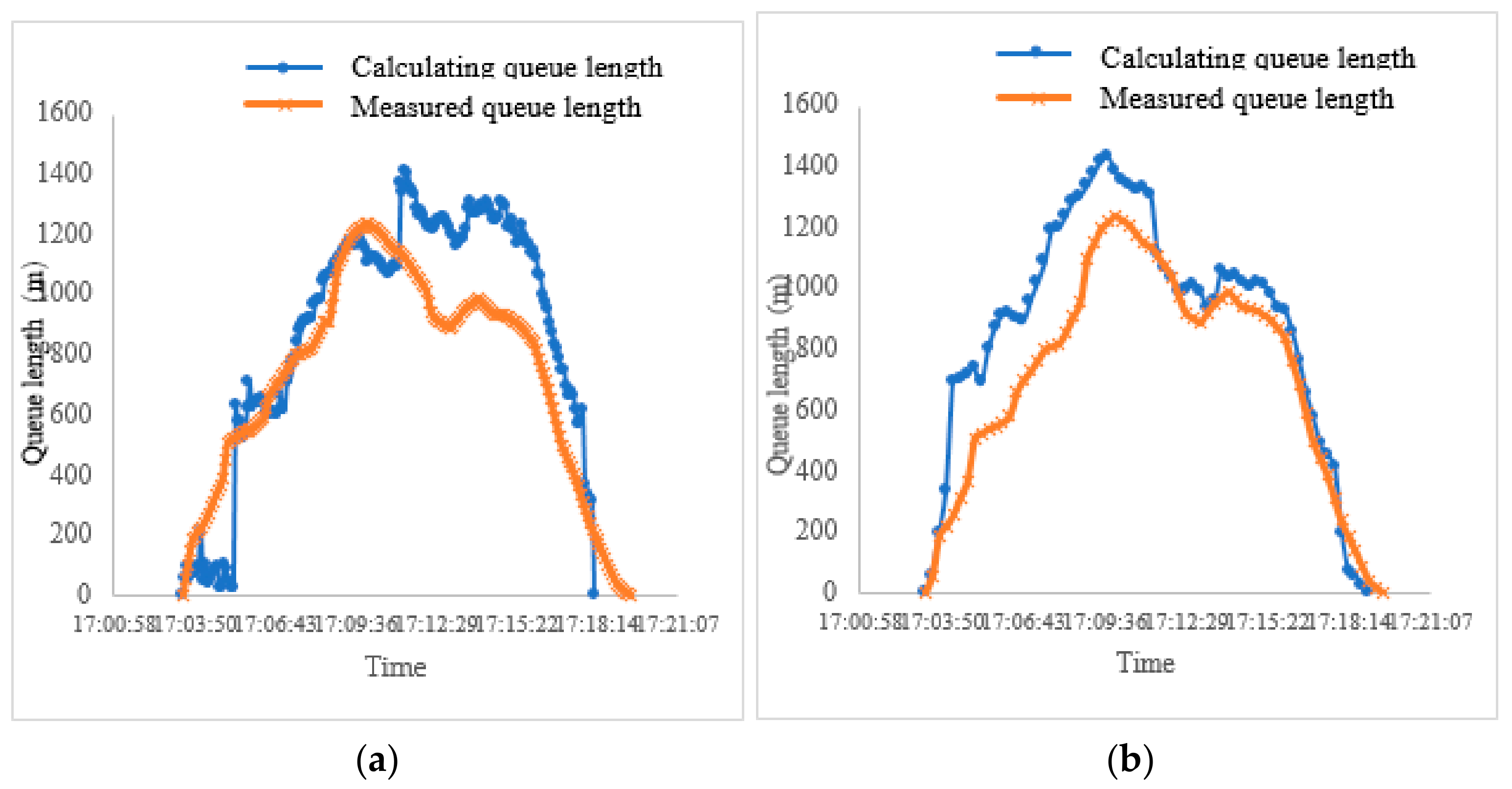
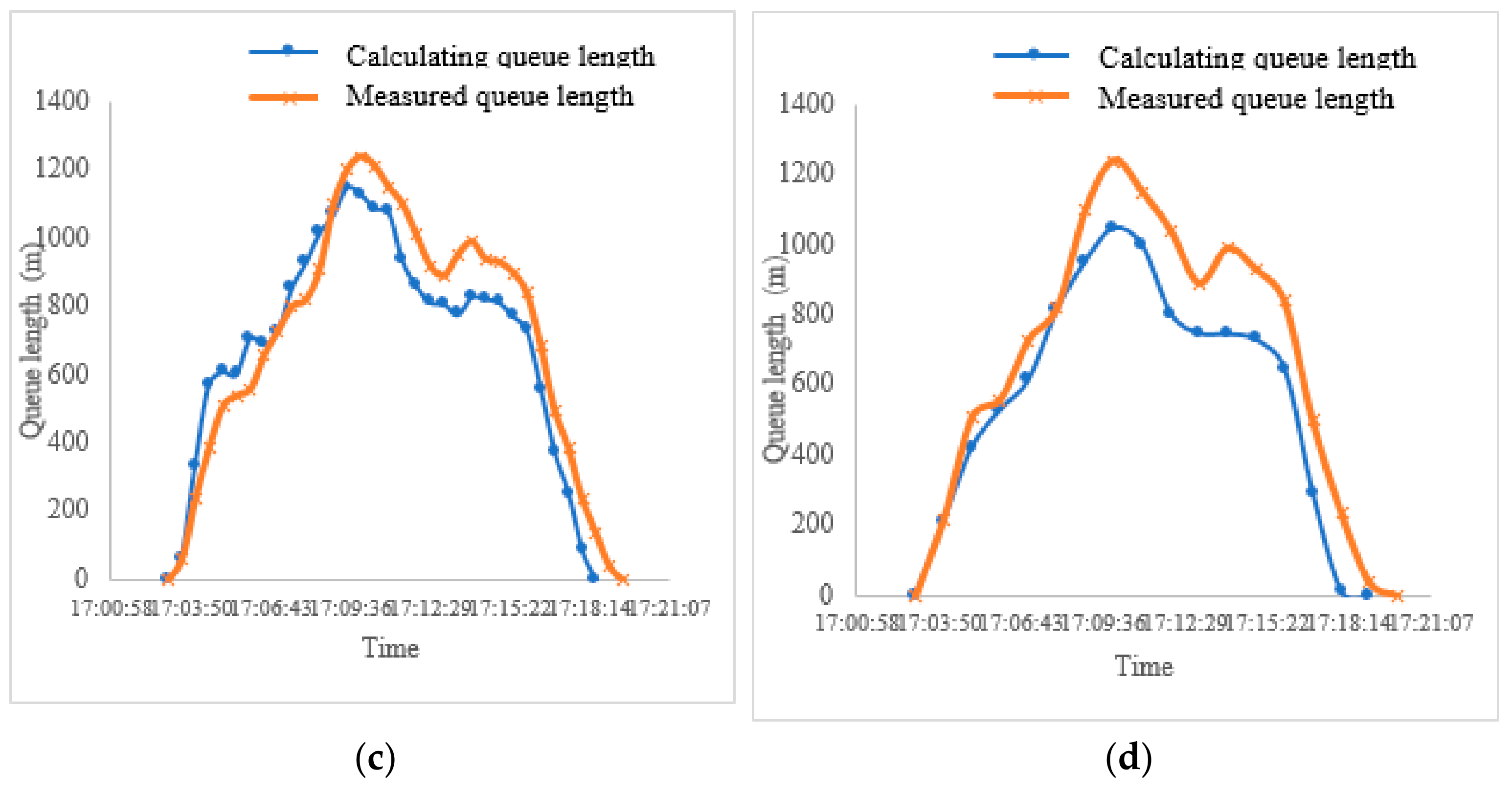


| Accident Number | Accident Vehicle Occupying Situation | Actual Measured Accident Residual Capacity (veh/h) | VISSIM Simulates the Residual Capacity of the Accident (veh/h) | Relative Error | Residual Capacity of HCM Accident (veh/h) | Relative Error |
|---|---|---|---|---|---|---|
| 1 | Occupy 1 lane(left) | 2820 | 2840 | 0.7% | 2087 | 26.0% |
| 2 | Occupy 1 lane(middle) | 2760 | 2840 | 2.9% | 2087 | 24.4% |
| 3 | Occupy 1 lane(right) | 2784 | 2840 | 2.0% | 2087 | 25.0% |
| 4 | Occupy 2 lane(left, right) | 1482 | 1360 | 8.2% | 724 | 51.1% |
| Variable | Implication | Value-Taking |
|---|---|---|
| average traffic flow of accident section | 2652 (veh/h) | |
| average upstream traffic demand | 4120 (veh/h) | |
| average density of accident section | 235 (veh/h) | |
| upstream average density | 60 (veh/h) | |
| time of accidents | 17:03 | |
| time of traffic control | 17:10 |
| Time | Density of Non-Congested Area (veh/km) | Traffic of Non-Congested Area (veh/h) | Density of Congested Area (veh/km) | Traffic of Congested Area (veh/h) | Shock-Wave Velocity (km/h) | Queue Length (m) | Queue-Length Absolute Value (m) |
|---|---|---|---|---|---|---|---|
| 17:04:00 | 59 | 4440 | 88 | 3490 | −33.05 | −335.38 | 335.38 |
| 17:04:30 | 81 | 4560 | 114 | 3620 | −28.55 | −573.29 | 573.29 |
| 17:05:00 | 52 | 4440 | 117 | 4140 | −4.64 | −611.92 | 611.92 |
| 17:05:30 | 74 | 3840 | 128 | 3890 | 0.93 | −604.21 | 604.21 |
| 17:06:00 | 74 | 4440 | 139 | 3610 | −12.75 | −710.50 | 710.50 |
| 17:06:30 | 74 | 3720 | 149 | 3890 | 2.26 | −691.65 | 691.65 |
| 17:07:00 | 81 | 3480 | 155 | 3150 | −4.48 | −728.95 | 728.95 |
| 17:07:30 | 74 | 4320 | 163 | 2960 | −15.27 | −856.16 | 856.16 |
| 17:08:00 | 74 | 3960 | 175 | 3070 | −8.83 | −929.71 | 929.71 |
| 17:08:30 | 59 | 4200 | 184 | 2890 | −10.50 | −1017.19 | 1017.19 |
| 17:09:00 | 59 | 3960 | 195 | 3090 | −6.43 | −1070.78 | 1070.78 |
| 17:09:30 | 74 | 4320 | 197 | 3130 | −9.72 | −1151.77 | 1151.77 |
| 17:10:00 | 89 | 3000 | 201 | 3270 | 2.42 | −1131.64 | 1131.64 |
| Time Intervals T/s | Maximum Queue-Length Accuracy | Whole-Process Queue-Length Accuracy |
|---|---|---|
| 5 | 78.38% | 64.01% |
| 15 | 84.73% | 69.27% |
| 30 | 93.62% | 83.05% |
| 60 | 85.96% | 73.11% |
| Time Intervals T/s | Maximum Queue-Length Accuracy | Whole-Process Queue-Length Accuracy |
|---|---|---|
| 5 | 86.16% | 76.41% |
| 15 | 85.74% | 75.09% |
| 30 | 81.08% | 72.56% |
| 60 | 72.91% | 59.46% |
| Time Intervals T/s | Maximum Queue-Length Accuracy | Whole-Process Queue-Length Accuracy |
|---|---|---|
| 5 | 71.47% | 53.63% |
| 15 | 72.64% | 68.22% |
| 30 | 95.62% | 84.34% |
| 60 | 86.27% | 76.15% |
| Time Intervals T/s | Unsmoothing | Smoothing for 30 s | Smoothing for 60 s | Smoothing for 90 s | ||||
|---|---|---|---|---|---|---|---|---|
| Maximum Queue-Length Accuracy | Whole-Process Queue-Length Accuracy | Maximum Queue-Length Accuracy | Whole-Process Queue-Length Accuracy | Maximum Queue-Length Accuracy | Whole-Process Queue-Length Accuracy | Maximum Queue-Length Accuracy | Whole-Process Queue-Length Accuracy | |
| 5 | 71.47% | 53.63% | 94.86% | 81.89% | 94.36% | 81.76% | 93.55% | 77.87% |
| 15 | 72.64% | 68.22% | 90.08% | 82.23% | 93.22% | 80.27% | 92.87% | 76.74% |
| 30 | 92.22% | 84.34% | 94.29% | 82.02% | 91.92% | 72.05% | 89.38% | 74.64% |
| 60 | 86.27% | 76.15% | 62.06% | 68.98% | 64.00% | 67.91% | 63.33% | 63.66% |
| Time Intervals T/s | Maximum Queue-Length Accuracy | Whole-Process Queue-Length Accuracy |
|---|---|---|
| model in this paper | 93.62% | 83.05% |
| input–output model | 87.24% | 73.85% |
Disclaimer/Publisher’s Note: The statements, opinions and data contained in all publications are solely those of the individual author(s) and contributor(s) and not of MDPI and/or the editor(s). MDPI and/or the editor(s) disclaim responsibility for any injury to people or property resulting from any ideas, methods, instructions or products referred to in the content. |
© 2023 by the authors. Licensee MDPI, Basel, Switzerland. This article is an open access article distributed under the terms and conditions of the Creative Commons Attribution (CC BY) license (https://creativecommons.org/licenses/by/4.0/).
Share and Cite
Xing, R.; Cai, X.; Liu, Y.; Yang, Z.; Wang, Y.; Peng, B. Study on Queue Length in the Whole Process of a Traffic Accident in an Extra-Long Tunnel. Mathematics 2023, 11, 1773. https://doi.org/10.3390/math11081773
Xing R, Cai X, Liu Y, Yang Z, Wang Y, Peng B. Study on Queue Length in the Whole Process of a Traffic Accident in an Extra-Long Tunnel. Mathematics. 2023; 11(8):1773. https://doi.org/10.3390/math11081773
Chicago/Turabian StyleXing, Ruru, Xiaoyu Cai, Yuan Liu, Zepeng Yang, Yuting Wang, and Bo Peng. 2023. "Study on Queue Length in the Whole Process of a Traffic Accident in an Extra-Long Tunnel" Mathematics 11, no. 8: 1773. https://doi.org/10.3390/math11081773






